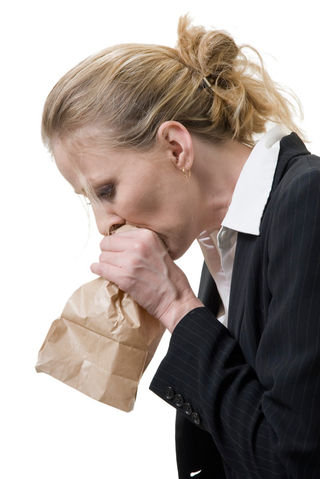Anxiety
A Fail-Safe Way for Dealing with Anxiety
Learn about an unexpected cause of anxiety and how to fix it.
Posted March 12, 2016

There's probably not a single adult who hasn't been told, "Stand up straight. Hold your stomach in.” In an effort to have good posture and to look your best, you may have acquired a bad habit. Instead of breathing from your diaphragm – and moving your stomach in and out – you've ended up breathing from your upper chest.
Why is this important? When you breathe primarily from your upper chest, you increase the risk of hyperventilating. Most people think of hyperventilation as panting. Panting, or gasping for air, is one form of hyperventilation, but it's not the only way you can hyperventilate. Other forms include sighing, yawning, holding your breath, or any forceful deep breath.
The Problem. Shallow, chest level breathing may leave you chronically hyperventilated. Hyperventilation alters your body’s chemistry ever so slightly. It changes the balance of such chemicals as carbon dioxide, calcium, oxygen, and bicarbonate. Although these alterations are not dangerous, they do have important consequences for those who are sensitive to the physical symptoms of anxiety.
Weird Symptoms. The results of hyperventilation take the form of many of the symptoms commonly associated with anxiety. For example, shortness of breath, lightheadedness, dizziness, clamminess, tingling or numbness, and derealization (feeling like you're walking around in a dream) are just some of the symptoms that result from hyperventilation.
If you're slightly hyperventilated to begin with, when you become anxious, there's a natural tendency to breathe even more quickly. As a result, you become more hyperventilated, thus creating a vicious cycle, and you end up experiencing all of those unpleasant symptoms of anxiety. You may find breathing retraining helps relieve many of your physical symptoms.
A Quick Test. Take one hand and place it just above your belt or your waist. Place your other hand in the middle of your chest right below your collarbone. Breathe as you normally would. Which hand is moving the most? If that hand on your chest is doing most of the moving, you'll likely benefit from learning a new way to breathe.
The Antidote: Paced Breathing. Paced breathing refers to a slower, more regular rate of breathing. You breathe from your diaphragm rather than from your upper chest. Your diaphragm is very large and strong muscle that separates your chest cavity from your abdominal cavity.
Learning Paced Breathing.
1. Breathe slowly. Ideally, you should be able to slow your rate of respiration down to 8 to 10 breaths per minute. It's not necessary to count. Simply concentrate on slowing down the pace of your breathing. This has the added benefit of shifting your attention away from any symptoms of anxiety that you may be experiencing.
2. Breathe through your nose. This helps you to prevent inadvertent hyperventilation. It's much easier to revert to shallow, upper chest breathing if you're reading through your mouth. Also, it's impossible to gasp air if you breathe through your nose.
3. Alternate paced and normal breathing. There is a normal balance between chest and diaphragmatic breaths. Don't expect that every single breath should come from your abdomen. The average number of diaphragmatic to upper chest breath is 4 to 1. Set your goal to shift the ratio in the favor of abdominal breathing.
Relaxation-induced Anxiety. Despite your best efforts, you may find that instead of your anxiety decreasing, it increases. This phenomenon is called relaxation-induced anxiety. It's the result of your body not being used to feeling really relaxed. Instead, an alarm goes off indicating that something out of the ordinary is happening. In effect, your body is right. You're relaxing and experiencing a sensation that's quite unfamiliar. Although the sensations maybe unsettling it first, the good news is that they will go away with practice.
Practice. Practice paced breathing several times a day for about 5 minutes during relatively calm periods. Later, after you're more familiar with this type of breathing, you can use it in more stressful situations.
Although getting rid of all anxiety is not possible, or even desirable, this technique will help lessen some of the annoying physical symptoms. And keep in mind, this is just one of many anxiety management techniques. If this one doesn't click with you, there are others.




